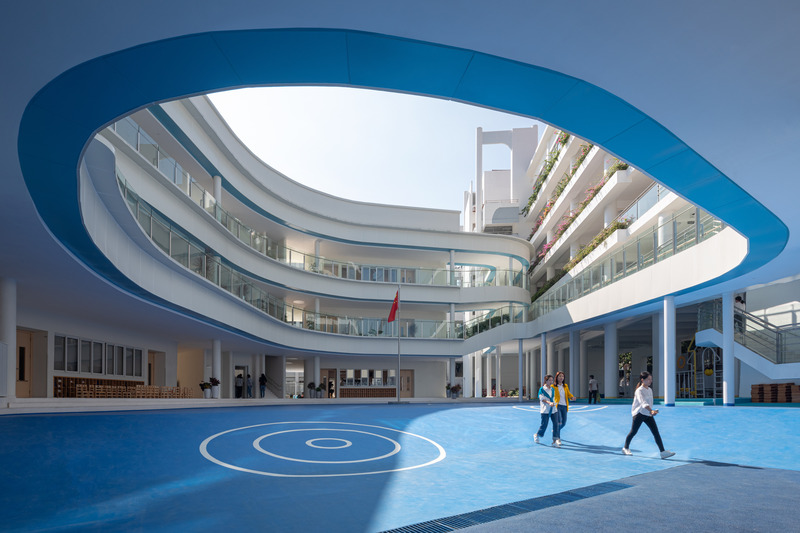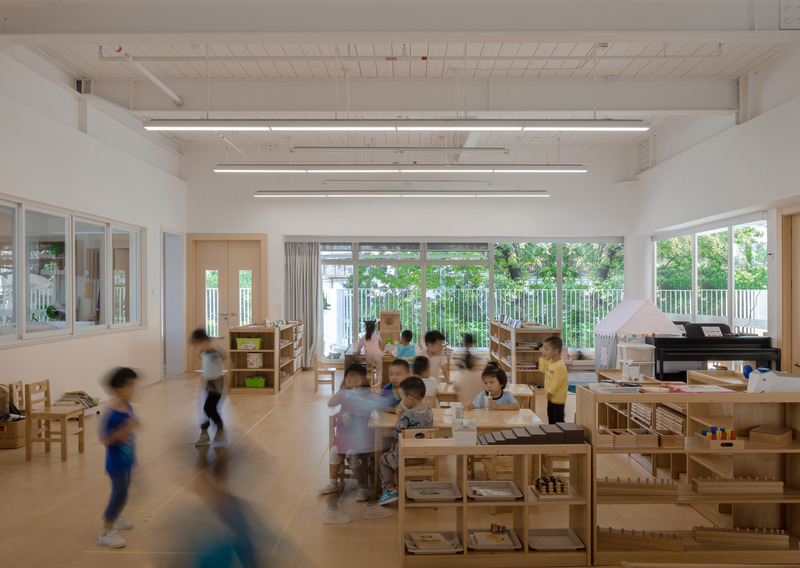Yunchao Xu, from Atelier Apeiron, introduces its latest design, the Kindergarten of Museum Forest. The project follows the “Apeironology” design philosophy, which Yunchao Xu has always practised, embracing the opening of boundaries, not restricting to definitions, crossing disciplinary lines, and not being limited to typologies.
“Children need a small town, rather than just a row of classrooms,” explains Yunchao Xu. “Surrounded by green trees, new blocks rise gently, and the flowing space slowly blooms, infusing greater happiness into this old neighborhood.”

A Corner of Campus
Photo credit: Schran Images
Modern society tames the flesh through disciplines, and social disciplines demand that people behave “correctly”. Discipline, Foucault believed, has become a prominent feature of modern education, permeating all of its aspects.
In the firm’s opinion, “a large playground, large classrooms, and multi-functional spaces” are the configurations that form a “good school”. But what about kindergarten-aged children? Yunchao Xu, the lead architect of Atelier Apeiron, believes that the definition of so-called “good schools” also provides a kind of spatial discipline for children. As the first step of children into society, kindergartens should be open and free.
Kindergarten of Museum Forest was founded in 1982, being part of one of the first batch of public kindergartens in Shenzhen. The schools have witnessed the growth of Shenzhen and form a large part of the childhood emotions and memories of the Shenzhen people. Given the land constraints of the area, in a crowded surrounding environment, and with limited investment in old buildings, people began to question the significance of the reconstruction. Within that context, Yunchao Xu seized the opportunity to participate in kindergarten projects for the first time.
“Recalling the design of this kindergarten is a process of letting go of the obsessiveness of an architect,” says Yunchao Xu.

Courtyard
Photo credit: Schran Images
Prior to the kindergarten projects, Yunchao Xu’s work was focused on large-scale buildings and urban planning for corporate headquarters, hi-tech parks, and cultural complexes. During his educational experience at Columbia University, in the United States, he studied under Steven Holl and Kenneth Frampton, where he developed a fascination for the classic aesthetics of modernist architecture. He applied his previous experiences to the kindergarten project, but none of the subsequent plans satisfied him.
Since then, Yunchao Xu visited the old campus and walked freely through the trees as he listened to the children playing. From the perspective of a father and an architect, he realized that young children have different emotional connections to the scale of space than adults do. From that moment, the children’s feelings became the focal point of the design. He believed that, for young children, a free connected walkway is more attractive than a large playground, and a small classroom, without boundaries, is more spacious than a large classroom with complete facilities.
Yunchao Xu thought the children may not warm up to the kindergarten if it were designed like an amusement park, which, in his view, is a place with established rules and discipline dictated by adults. The amusement park-style campus is only an illusion to satisfy parents. “The games will be no fun if there are too many rules,” notes Yunchao Xu. He also compared the amusement park to a colouring book, where children may prefer a blank page to doodle on, rather than following a preestablished reference. The architect believes that children’s imaginations are limited by “noisy” colours and abundant facilities. Compared to an activity room filled with toys, children may prefer to establish their own rules of the game in blank spaces left for them to explore.

Site Plan
Photo credit: Schran Images
With no presuppositions, exaggerated shapes, or child-like colours, the spaces don’t resemble what most would define as a “kindergarten”. Creamy white exterior walls, warm wood-coloured interiors, and clean and transparent glass reside in stark contrast to the crowded community, yet blend together. The light reflections on the brushed surfaces invoke a sense of tenderness, and the soft and rounded outline and staggered volumes show a gentle and modest posture with the change of sunlight.
In analyzing the surrounding landscape resources, axes in different directions appear, ensuring that the classroom windows avoid the influences of the residential blocks and the main road. The classrooms are staggered to form a visual corridor from the inside out. At the same time, the Kindergarten of Museum Forest enjoys abundant natural sunlight and smooth ventilation. Yunchao Xu introduced the community landscape into the campus through a way of “borrowed scenery”, ensuring that children are in frequent touch with nature throughout the campus. Each classroom is surrounded by nature, and a walk outside leads into the forest.
The organic layout took shape naturally, and the new building blooms like a flower, gently growing and spreading outward. The transparent flow spaces eliminate isolated dead corners, forming a circulation through the campus. Narrow gaps become clear passages for children to shuttle back and forth through.

The Deer Sculpture
Photo credit: Schran Images
An oval circular corridor connects with the entrance on the first floor, and the sky corridor connects the old and the new building on the second floor. Those connections create a space system that protects children from the sun and rain. The effects of the system far exceed the expectations of Yunchao Xu, despite being opposed to the approach on a cost basis at the beginning.
“The biggest difference between kindergarten design and other institutional buildings is not the scale, but the efficiency,” expresses Yunchao Xu.
In primary and secondary school designs, “efficient” is often the most commonly mentioned word. Undoubtedly, the shortest distance between two points is the most efficient for students to move from the teaching building to the playground and the cafeteria. However, the campus layout is always designed with a specific purpose. “Efficiency” is not available for young children, who have different interpretations of space and time when they shuttle between two points. Along the way, they are likely to be distracted by things like little butterflies, which adds time to the commute. They may prefer the path with fragrant flowers, beautiful clouds, and flying birds.

Undefined Space
Photo credit: Schran Images
The blank spaces of the campus no longer define where, when, and what children do. They can choose to play hide-and-seek, build sand castles, plant flowers, pick leaves, set up a tent, or even have a bicycle race on the terraces. The undefined spaces allow activities to happen spontaneously – anywhere at any time. The borderless classrooms connected to the terraces allow children to feel free in an atmosphere where the curriculum can be no longer confined to the classroom. Blank walls and floors will become the background canvas for children and teachers to create new dreams together, accumulating and carrying forward memories in more artistic ways.
“I hope that children can find the ninety-nine languages here,” concludes Yunchao Xu, referencing One Hundred Languages of Children and its belief that a child has a hundred languages, but steals ninety-nine. “The building has been delivered, but the design is far from finished.”
The flow corridor platforms render efficiency meaningless, and the unblocked sightlines and nature sit in stark contrast to the restricted environment. This small kindergarten has become an expansive paradise, free of boundaries from a child’s perspective.

Interior
Photo credit: Schran Images
During construction, in addition to preserving old trees, Yunchao Xu also preserved a deer sculpture that has been a part of the campus for 40 years. A teacher who worked in the kindergarten for many years, and who is also a friend of Yunchao Xu, said “I saw how the new building, together with the old building, embrace the courtyard, and the white deer sculpture is still there. I am very gratified and happy.”
For the completion and operation of the Kindergarten of Museum Forest, Yunchao Xu also expressed his wish for what he expects the building to be: something as undefined and unconstrained as the growth of children. The building can accompany and grow with the children and teachers, with the flexibility to adapt to new needs at any time.
Video credit: Yunchao Xu/Aterlie Apeiron
Source: v2com newswire









